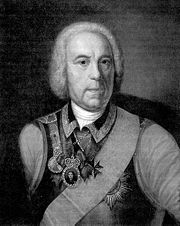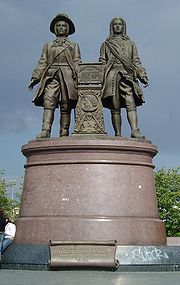
Georg Wilhelm de Gennin
Encyclopedia


Germans
The Germans are a Germanic ethnic group native to Central Europe. The English term Germans has referred to the German-speaking population of the Holy Roman Empire since the Late Middle Ages....
-born Russian
Russian Empire
The Russian Empire was a state that existed from 1721 until the Russian Revolution of 1917. It was the successor to the Tsardom of Russia and the predecessor of the Soviet Union...
military officer and engineer who specialized in mining
Mining
Mining is the extraction of valuable minerals or other geological materials from the earth, from an ore body, vein or seam. The term also includes the removal of soil. Materials recovered by mining include base metals, precious metals, iron, uranium, coal, diamonds, limestone, oil shale, rock...
and metallurgy
Metallurgy
Metallurgy is a domain of materials science that studies the physical and chemical behavior of metallic elements, their intermetallic compounds, and their mixtures, which are called alloys. It is also the technology of metals: the way in which science is applied to their practical use...
.
He was born as Georg Wilhelm Hennin (Henning) in Siegerland
Siegerland
The Siegerland is a region of Germany covering the old district of Siegen and the upper part of the district of Altenkirchen, belonging to the Rhineland-Palatinate adjoining it to the west.Geologically, the Siegerland belongs to the Rheinisches Schiefergebirge...
, then County of Nassau
Nassau (state)
Nassau was a German state within the Holy Roman Empire and later in the German Confederation. Its ruling dynasty, now extinct in male line, was the House of Nassau.-Origins:...
(while other sources mention Lower Saxony
Lower Saxony
Lower Saxony is a German state situated in north-western Germany and is second in area and fourth in population among the sixteen states of Germany...
). During the Grand Embassy of Peter I
Grand Embassy of Peter I
The Grand Embassy was a Russian diplomatic mission, sent to Western Europe in 1697-1698 by Peter the Great....
in 1697 Franz Lefort
Franz Lefort
Franz Lefort was a Russian military figure of Swiss origin, general admiral , and close associate of Peter the Great....
invited him to join the Russian Imperial army. During the Great Northern War
Great Northern War
The Great Northern War was a conflict in which a coalition led by the Tsardom of Russia successfully contested the supremacy of the Swedish Empire in northern Central Europe and Eastern Europe. The initial leaders of the anti-Swedish alliance were Peter I the Great of Russia, Frederick IV of...
, Gennin excelled as an artillerist and fortification engineer. In 1728, he was promoted Lieutenant-General.
At first Gennin managed the iron founderies of Olonets
Olonets
Olonets is a town and the administrative center of Olonetsky District of the Republic of Karelia, Russia, situated on the Olonka River, to the east from Lake Ladoga. Population: -History:...
. He is considered one of the founders of Petrozavodsk
Petrozavodsk
Petrozavodsk is the capital city of the Republic of Karelia, Russia. It stretches along the western shore of the Lake Onega for some . The city is served by Petrozavodsk Airport. Municipally, it is incorporated as Petrozavodsky Urban Okrug . Population:...
. In 1722, he moved to the Ural
Ural (region)
Ural is a geographical region located around the Ural Mountains, between the East European and West Siberian plains. It extends approximately from north to south, from the Arctic Ocean to the bend of Ural River near Orsk city. The boundary between Europe and Asia runs along the eastern side of...
, where he served for 12 years as a manager of Ural government factories. Together with Vasily Tatischev, he was active in the foundation of the cities of Yekaterinburg
Yekaterinburg
Yekaterinburg is a major city in the central part of Russia, the administrative center of Sverdlovsk Oblast. Situated on the eastern side of the Ural mountain range, it is the main industrial and cultural center of the Urals Federal District with a population of 1,350,136 , making it Russia's...
and Perm
Perm
Perm is a city and the administrative center of Perm Krai, Russia, located on the banks of the Kama River, in the European part of Russia near the Ural Mountains. From 1940 to 1957 it was named Molotov ....
.
Gennin was the author of the book "Description of Ural and Siberian factories", where for the first time he gives the geographical and historical description of the Perm Krai
Perm Krai
Perm Krai is a federal subject of Russia that came into existence on December 1, 2005 as a result of the 2004 referendum on the merger of Perm Oblast and Komi-Permyak Autonomous Okrug. The city of Perm became the administrative center of the new federal subject...
, including the Yagoshikhinskiy, Pyskorskiy and Suksunstiy factories with drawings.

